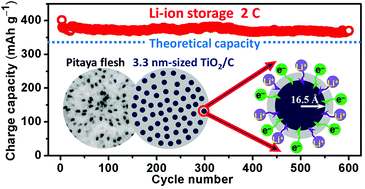Our official English website, www.x-mol.net, welcomes your
feedback! (Note: you will need to create a separate account there.)
3.3 nm-sized TiO2/carbon hybrid spheres endowed with pseudocapacitance-dominated superhigh-rate Li-ion and Na-ion storage
Nanoscale ( IF 5.8 ) Pub Date : 2020/03/04 , DOI: 10.1039/c9nr10750a Hao Luo 1, 2, 3, 4, 5 , Yuxi Chen 1, 2, 3, 4, 5 , Jing Huang 1, 2, 3, 4, 5 , Zhanglong Chen 1, 2, 3, 4, 5 , Xiaohong Xia 1, 2, 3, 4, 5 , Jin Li 1, 2, 3, 4, 5 , Hongbo Liu 1, 2, 3, 4, 5
Nanoscale ( IF 5.8 ) Pub Date : 2020/03/04 , DOI: 10.1039/c9nr10750a Hao Luo 1, 2, 3, 4, 5 , Yuxi Chen 1, 2, 3, 4, 5 , Jing Huang 1, 2, 3, 4, 5 , Zhanglong Chen 1, 2, 3, 4, 5 , Xiaohong Xia 1, 2, 3, 4, 5 , Jin Li 1, 2, 3, 4, 5 , Hongbo Liu 1, 2, 3, 4, 5
Affiliation

|
Decreasing the particle size of nanoscaled battery materials will induce amazing enhancement effects on their charging rates, which holds a promise to overcome the common bottleneck of the low charging rates of batteries. However, the fabrication of ultrafine-sized battery materials remains a great challenge. Herein, 3.3 nm-sized anatase TiO2 particles embedded in electrically and ionically conductive carbon spheres have been designed and fabricated via the suppression of Ostwald ripening with the aim to obtain insight into the electrochemical behaviors of ultrafine-sized materials. The pseudocapacitive and diffusion-controlled intercalative characteristics of the 3.3 nm-sized TiO2/carbon hybrid spheres for Li-ion and Na-ion storage have been systematically investigated via a cyclic voltammetry (CV) method combined with a differential capacitance method that is introduced here for the first time to analyze battery materials. CV and galvanostatic voltage profiles demonstrate that pseudocapacitance dominates the charge storage and increases with cycling for both Li-ion and Na-ion storage. Capacitance accounts for >83% of the Li-ion storage. A specific pseudocapacitance of 558 F g−1 with a window voltage of ∼2 V in carbonate electrolyte has been achieved. The reversible capacity is higher than the theoretical capacity of TiO2 after 600 discharge/charge cycles at 2 C and maintains ∼60% of that of TiO2 even at 80 C (45 s for full discharge or charge). For Na-ion storage, a high cycliability of 2500 discharge/charge cycles has been obtained at 2 C. Capacitance accounts for ∼79% of the Na-ion storage with cycling. Ultrafine-sized materials are very promising electrode candidates for constructing pseudocapacitive batteries possessing both high energy and power densities.
中文翻译:

3.3纳米尺寸的TiO2 /碳杂化球具有伪电容为主的超高速锂离子和钠离子存储
减小纳米级电池材料的粒度将对它们的充电速率产生惊人的增强效果,这有望克服电池低充电速率的常见瓶颈。然而,超细尺寸电池材料的制造仍然是巨大的挑战。本文中,通过抑制奥斯特瓦尔德熟化,设计和制造了嵌入在导电和离子导电碳球中的3.3 nm尺寸的锐钛矿型TiO 2颗粒,目的是了解超细尺寸材料的电化学行为。3.3 nm尺寸的TiO 2的拟电容和扩散控制的嵌入特性通过循环伏安法(CV)与差分电容方法相结合,系统地研究了用于锂离子和钠离子存储的碳/碳混合球体,该方法首次在此引入,用于分析电池材料。CV和恒电流电压曲线表明,假电容在电荷存储中占主导地位,并且随着锂离子和钠离子存储的循环而增加。电容占锂离子电池存储量的83%以上。在碳酸盐电解质中,具有约2 V的窗口电压的558 F g -1的比拟电容。在2 C下经过600次充放电循环后,可逆容量高于TiO 2的理论容量,并保持TiO 2的〜60%即使在80 C(45 s完全放电或充电)下也是如此。对于Na离子存储,在2 C下获得了2500个放电/充电循环的高可循环性。在循环中,电容约占Na离子存储的79%。超细尺寸的材料是非常有前途的电极候选材料,可用于构建同时具有高能量和功率密度的伪电容电池。
更新日期:2020-04-03
中文翻译:

3.3纳米尺寸的TiO2 /碳杂化球具有伪电容为主的超高速锂离子和钠离子存储
减小纳米级电池材料的粒度将对它们的充电速率产生惊人的增强效果,这有望克服电池低充电速率的常见瓶颈。然而,超细尺寸电池材料的制造仍然是巨大的挑战。本文中,通过抑制奥斯特瓦尔德熟化,设计和制造了嵌入在导电和离子导电碳球中的3.3 nm尺寸的锐钛矿型TiO 2颗粒,目的是了解超细尺寸材料的电化学行为。3.3 nm尺寸的TiO 2的拟电容和扩散控制的嵌入特性通过循环伏安法(CV)与差分电容方法相结合,系统地研究了用于锂离子和钠离子存储的碳/碳混合球体,该方法首次在此引入,用于分析电池材料。CV和恒电流电压曲线表明,假电容在电荷存储中占主导地位,并且随着锂离子和钠离子存储的循环而增加。电容占锂离子电池存储量的83%以上。在碳酸盐电解质中,具有约2 V的窗口电压的558 F g -1的比拟电容。在2 C下经过600次充放电循环后,可逆容量高于TiO 2的理论容量,并保持TiO 2的〜60%即使在80 C(45 s完全放电或充电)下也是如此。对于Na离子存储,在2 C下获得了2500个放电/充电循环的高可循环性。在循环中,电容约占Na离子存储的79%。超细尺寸的材料是非常有前途的电极候选材料,可用于构建同时具有高能量和功率密度的伪电容电池。









































 京公网安备 11010802027423号
京公网安备 11010802027423号